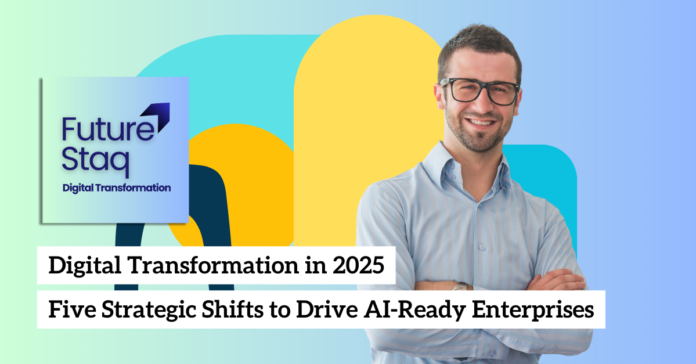By 2025, digital transformation will be less about flashy tech deployments and more about seamless integration of artificial intelligence (AI) across every facet of the business. Enterprises that succeed will do so by rethinking their operating models, workforce skills, data governance, and security protocols — all while staying laser-focused on tangible outcomes rather than lofty promises. Below are five emerging shifts shaping what successful AI-ready digital transformation looks like in practice.
1. Elevating Leadership and Building AI Proficiency
Prioritizing Human-Centric Strategy
As AI moves from buzzword to operational cornerstone, leaders who cultivate cross-functional expertise will drive more cohesive strategies. CIOs and enterprise architects can no longer silo innovation within IT; instead, they must engage stakeholders from product management, sales, HR, and beyond to align AI solutions with measurable business goals.
Practical Recommendations
- Develop AI Champions – Identify individuals with both technical aptitude and strategic insight. Equip them with specialized training in machine learning, data privacy regulations, and agile methods so they can spearhead projects that deliver tangible value.
- Invest in Continuous Learning – Offer micro-courses and guided workshops on AI-driven tools. This approach helps employees feel less overwhelmed and more empowered, creating a culture that supports active experimentation and problem solving.
Why It Matters Organizations that cultivate a workforce ready to leverage AI will see better alignment between technology initiatives and real business challenges. By embedding AI literacy throughout the company, CIOs ensure that digital transformation isn’t just IT’s responsibility but everyone’s opportunity.
2. Rethinking Ambitious AI Ventures That Lack a Clear Return
Transitioning to Practical, ROI-Focused Initiatives
For several years, numerous organizations invested in AI projects hoping for disruptive breakthroughs. In 2025, the boardroom conversation has shifted toward demonstrable value. Proposed AI initiatives must present a well-defined business case and a pathway to near- or medium-term ROI.
Practical Recommendations
- Start with Efficiency Gains – Pick projects that reduce operational costs, automate repetitive tasks, or enhance decision-making in visible ways. Use these early successes to fund subsequent, more forward-looking innovations.
- Adopt Incremental Pilots – Initiate small-scale AI experiments, measure their outcomes rigorously, and expand once they prove successful. This staged approach curbs risk and builds stakeholder confidence.
Why It Matters When organizations chase high-profile but poorly scoped AI projects, they risk “experiment fatigue” and eroding trust. In contrast, adopting a more focused approach ensures consistent buy-in and bolsters the organization’s ability to deliver AI solutions that truly move the needle.
3. Bringing Data Governance and Responsible AI to Center Stage
Fostering Trust Through Strong Frameworks
AI solutions are only as effective as the data they rely on. By 2025, companies are recognizing that robust data governance — defining how data is stored, accessed, and protected — is inseparable from long-term AI success. The next wave of transformation demands clearly articulated policies on data usage, transparency in AI model outputs, and a culture that respects both privacy and regulatory obligations.
Practical Recommendations
- Link Data and AI Governance – Develop integrated guidelines covering everything from data classification to AI bias testing. Involve cross-functional teams — including legal, compliance, and operations — for a holistic approach.
- Prioritize Data Security – Implement encryption, access controls, and real-time monitoring to safeguard sensitive information. This extends to training employees on identifying and reporting potential security lapses.
Why It Matters High-quality data underpins accurate insights; weak governance invites errors, ethical concerns, and reputational damage. Establishing transparent data and AI governance helps ensure that AI-driven recommendations are grounded in trusted, well-managed information.
4. Moving Away from Conventional Migrations and Basic Automations
Toward Outcome-Driven Transformations
Simply migrating legacy systems to the cloud or automating individual tasks is no longer enough. By 2025, savvy CIOs focus on refining entire workflows to capitalize on the cloud’s advanced features and harness AI’s predictive capabilities. This shift moves teams away from performing technology upgrades in isolation and toward orchestrating transformations that genuinely improve how people work.
Practical Recommendations
- Rethink Workflows Before Migrating – Evaluate existing processes to decide which should be refactored or redesigned entirely. True transformation leverages AI to optimize bottlenecks, not just replicate them in a new environment.
- Automate for Strategic Value – Rather than using robotic process automation to replicate inefficient tasks, combine AI-driven insights with process redesign to unlock meaningful productivity gains and cost benefits.
Why It Matters Modernizing infrastructure without upgrading processes often leads to disappointment and wasted resources. A more transformative approach ensures that migrations and automations actually elevate employee experiences, customer satisfaction, and bottom-line results.
5. Heightening Focus on Security Training and Trust-Building
Preparing for Evolving Threats
AI can be a powerful ally — but malicious actors also benefit from sophisticated AI techniques, including deepfakes and advanced social engineering. Given this reality, security leaders must stay one step ahead by proactively training employees and integrating robust security measures throughout the enterprise’s AI lifecycle.
Practical Recommendations
- Embed Security in Every Project – Partner with IT, legal, and compliance teams early in a project’s life cycle to identify vulnerabilities and implement preventative controls.
- Regularly Update Training – Short, interactive modules on topics like detecting AI-based phishing, spotting deepfake videos, or safeguarding data in collaborative environments should be mandatory for all employees.
Why It Matters A security breach can cripple an organization’s transformation ambitions, erode trust among clients, and invite significant regulatory penalties. Proactive security and privacy measures protect both your people and your reputation, ensuring that AI-driven initiatives can scale safely.
Conclusion – Building a Future-Proof Transformation Roadmap
In 2025, “digital transformation” is no longer about launching the trendiest technologies or pursuing experimental AI programs without a plan. The focus has shifted to AI-ready digital transformation that emphasizes human capital, trustworthy data and models, practical (yet innovative) approaches, and a strong culture of security and ethical accountability.
Leaders who adopt these strategies will be better positioned to navigate shifting economic climates, meet demanding customer expectations, and fuel ongoing innovation. By balancing ambition with outcome-driven results, CIOs and enterprise architects can guide their organizations through the evolving technological landscape — and come out stronger, more agile, and genuinely transformative.
For the latest updates on business software and digital transformation, subscribe to Staq Insider
Need expert help to select and purchase the right software stack, check Staq42




